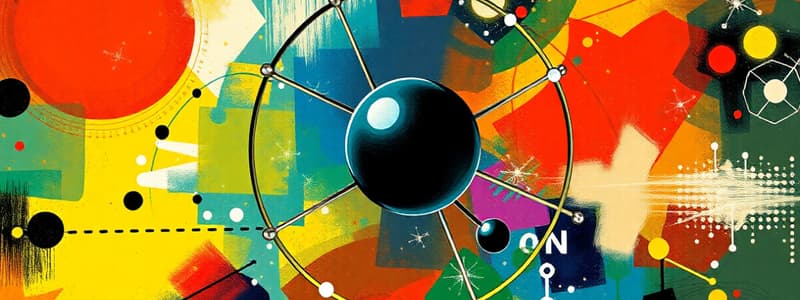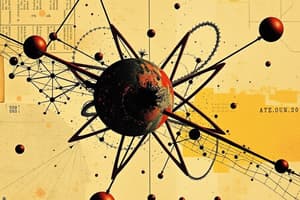Podcast
Questions and Answers
What is the relative atomic mass (R.A.M.) of chlorine calculated from its isotopes?
What is the relative atomic mass (R.A.M.) of chlorine calculated from its isotopes?
- 34.5
- 36.5
- 35.5 (correct)
- 35.0
What percentage of the chlorine sample is chlorine-37?
What percentage of the chlorine sample is chlorine-37?
- 70%
- 30%
- 25% (correct)
- 50%
Which formula correctly represents the calculation used to determine the R.A.M. of chlorine?
Which formula correctly represents the calculation used to determine the R.A.M. of chlorine?
- (35 x 25) + (37 x 75) / 100
- ((35 x 75) + (37 x 25)) / 100 (correct)
- (35 x 75) + (37 x 25) / 100
- (35 x 75) + (37 x 25)
If the abundance of chlorine-35 were 80% instead of 75%, what would the new R.A.M. of chlorine approximately be?
If the abundance of chlorine-35 were 80% instead of 75%, what would the new R.A.M. of chlorine approximately be?
What would happen to the R.A.M. if chlorine-37 were not present in the sample?
What would happen to the R.A.M. if chlorine-37 were not present in the sample?
What is the relative charge of a neutron?
What is the relative charge of a neutron?
What is the mass number of an atom if it has 6 protons and 8 neutrons?
What is the mass number of an atom if it has 6 protons and 8 neutrons?
How do isotopes of an element differ?
How do isotopes of an element differ?
What primarily constitutes the mass of an atom?
What primarily constitutes the mass of an atom?
Why do atoms contain an equal number of protons and electrons?
Why do atoms contain an equal number of protons and electrons?
What happens to the relative atomic mass of an element if it has different isotopes?
What happens to the relative atomic mass of an element if it has different isotopes?
What is the relationship between atomic number and the number of protons in an atom?
What is the relationship between atomic number and the number of protons in an atom?
How can the number of neutrons in an atom be calculated?
How can the number of neutrons in an atom be calculated?
What defines the identity of an element?
What defines the identity of an element?
What is the relative mass of an electron compared to a proton?
What is the relative mass of an electron compared to a proton?
What was one of the key points of Dalton's atomic theory?
What was one of the key points of Dalton's atomic theory?
What did J.J. Thomson discover using the cathode-ray tube?
What did J.J. Thomson discover using the cathode-ray tube?
Which model did J.J. Thomson propose?
Which model did J.J. Thomson propose?
What significant finding came from Rutherford's gold foil experiment?
What significant finding came from Rutherford's gold foil experiment?
According to Rutherford's model, what occupies the center of the atom?
According to Rutherford's model, what occupies the center of the atom?
Which of the following statements about Dalton's atomic theory is incorrect?
Which of the following statements about Dalton's atomic theory is incorrect?
What did Rutherford conclude about the behavior of positively charged particles in his experiment?
What did Rutherford conclude about the behavior of positively charged particles in his experiment?
How did scientists' understanding of atoms change because of the discovery of subatomic particles?
How did scientists' understanding of atoms change because of the discovery of subatomic particles?
What does the term 'plum-pudding model' refer to in atomic theory?
What does the term 'plum-pudding model' refer to in atomic theory?
In what manner did Rutherford's model differ from Dalton's original theory?
In what manner did Rutherford's model differ from Dalton's original theory?
Flashcards
Dalton's Atomic Theory
Dalton's Atomic Theory
John Dalton proposed that all matter is made up of tiny, indivisible particles called atoms.
Atoms of the same element are identical.
Atoms of the same element are identical.
Dalton's theory stated that atoms of the same element are identical, while atoms of different elements are different.
Atoms are indivisible.
Atoms are indivisible.
Dalton's hypothesis that atoms cannot be created, divided, or destroyed was later disproved by the discovery of subatomic particles.
Discovery of Electrons
Discovery of Electrons
Signup and view all the flashcards
Plum Pudding Model
Plum Pudding Model
Signup and view all the flashcards
Rutherford's Gold Foil Experiment
Rutherford's Gold Foil Experiment
Signup and view all the flashcards
Rutherford's Nuclear Model
Rutherford's Nuclear Model
Signup and view all the flashcards
Revision of Dalton's Atomic Theory
Revision of Dalton's Atomic Theory
Signup and view all the flashcards
Atoms are divisible.
Atoms are divisible.
Signup and view all the flashcards
Evolution of Atomic Models
Evolution of Atomic Models
Signup and view all the flashcards
What is the nucleus of an atom?
What is the nucleus of an atom?
Signup and view all the flashcards
What are protons?
What are protons?
Signup and view all the flashcards
What are neutrons?
What are neutrons?
Signup and view all the flashcards
What are electrons?
What are electrons?
Signup and view all the flashcards
Why are atoms electrically neutral?
Why are atoms electrically neutral?
Signup and view all the flashcards
What is the mass number of an atom?
What is the mass number of an atom?
Signup and view all the flashcards
What is the definition of an element based on its atomic structure?
What is the definition of an element based on its atomic structure?
Signup and view all the flashcards
What are isotopes?
What are isotopes?
Signup and view all the flashcards
Why are the relative atomic masses of some elements not whole numbers?
Why are the relative atomic masses of some elements not whole numbers?
Signup and view all the flashcards
What is relative atomic mass (RAM)?
What is relative atomic mass (RAM)?
Signup and view all the flashcards
What is percentage abundance of an isotope?
What is percentage abundance of an isotope?
Signup and view all the flashcards
How is Relative Atomic Mass (RAM) calculated?
How is Relative Atomic Mass (RAM) calculated?
Signup and view all the flashcards
Calculate the RAM of chlorine using the given data. (Chlorine-35, 75%, Chlorine-37, 25%)
Calculate the RAM of chlorine using the given data. (Chlorine-35, 75%, Chlorine-37, 25%)
Signup and view all the flashcards
Study Notes
Atomic Structure
- Atoms are the basic building blocks of matter
- Atoms cannot be created, divided, or destroyed
- Atoms of the same element are identical
- Atoms join to make new substances
Dalton's Atomic Theory (1803)
- All substances are made of atoms
- Atoms of the same element are identical
- Atoms of different elements are different
- Atoms combine to form new substances
J.J. Thomson's Model (1897)
- Atoms can be divided into smaller parts
- Atoms contain negatively charged particles called electrons
- Electrons are scattered throughout a positively charged "pudding"
Ernest Rutherford's Model (1909)
- Atoms are mostly empty space
- Most of the mass is concentrated in a tiny, dense nucleus
- Electrons orbit the nucleus
Subatomic Particles
- Proton: Positive charge, relative mass 1
- Neutron: No charge, relative mass 1
- Electron: Negative charge, relative mass 1/1836
Atomic Structure Summary
- Atoms are composed of a nucleus containing protons and neutrons, surrounded by electrons in shells
- Atoms have equal numbers of protons and electrons, resulting in a neutral charge
- The nucleus is a very small region compared to the overall size of the atom
- Most of the atomic mass is concentrated in the nucleus
Isotopes
- Isotopes are atoms of the same element with the same number of protons but different numbers of neutrons
- Isotopes have different mass numbers
Relative Atomic Mass (R.A.M)
- An average of the masses of all the isotopes of an element, weighted by their relative abundance
- R.A.M is not a whole number because it is an average
- ¹²C is taken as the standard for comparison = 12
Studying That Suits You
Use AI to generate personalized quizzes and flashcards to suit your learning preferences.



